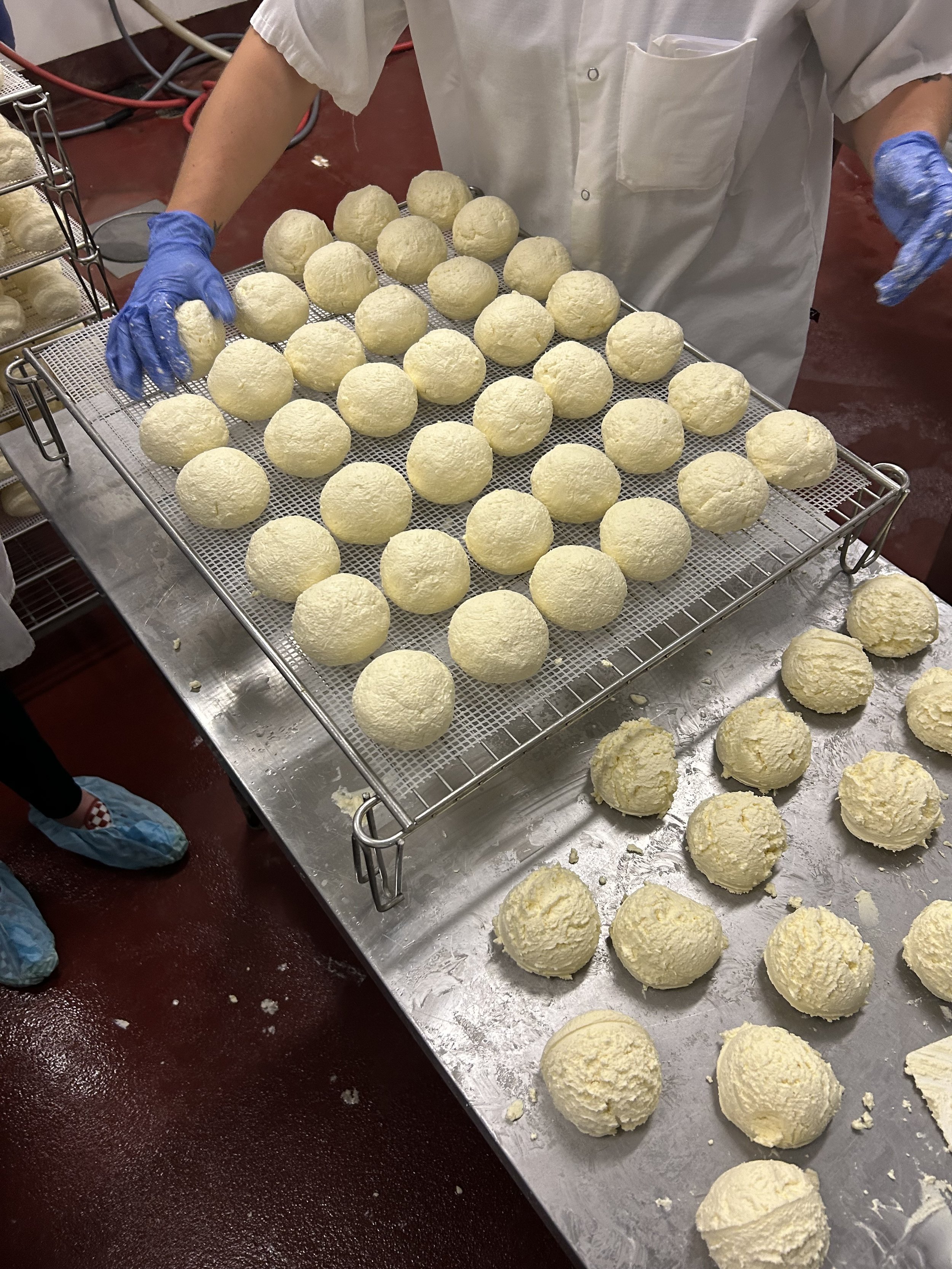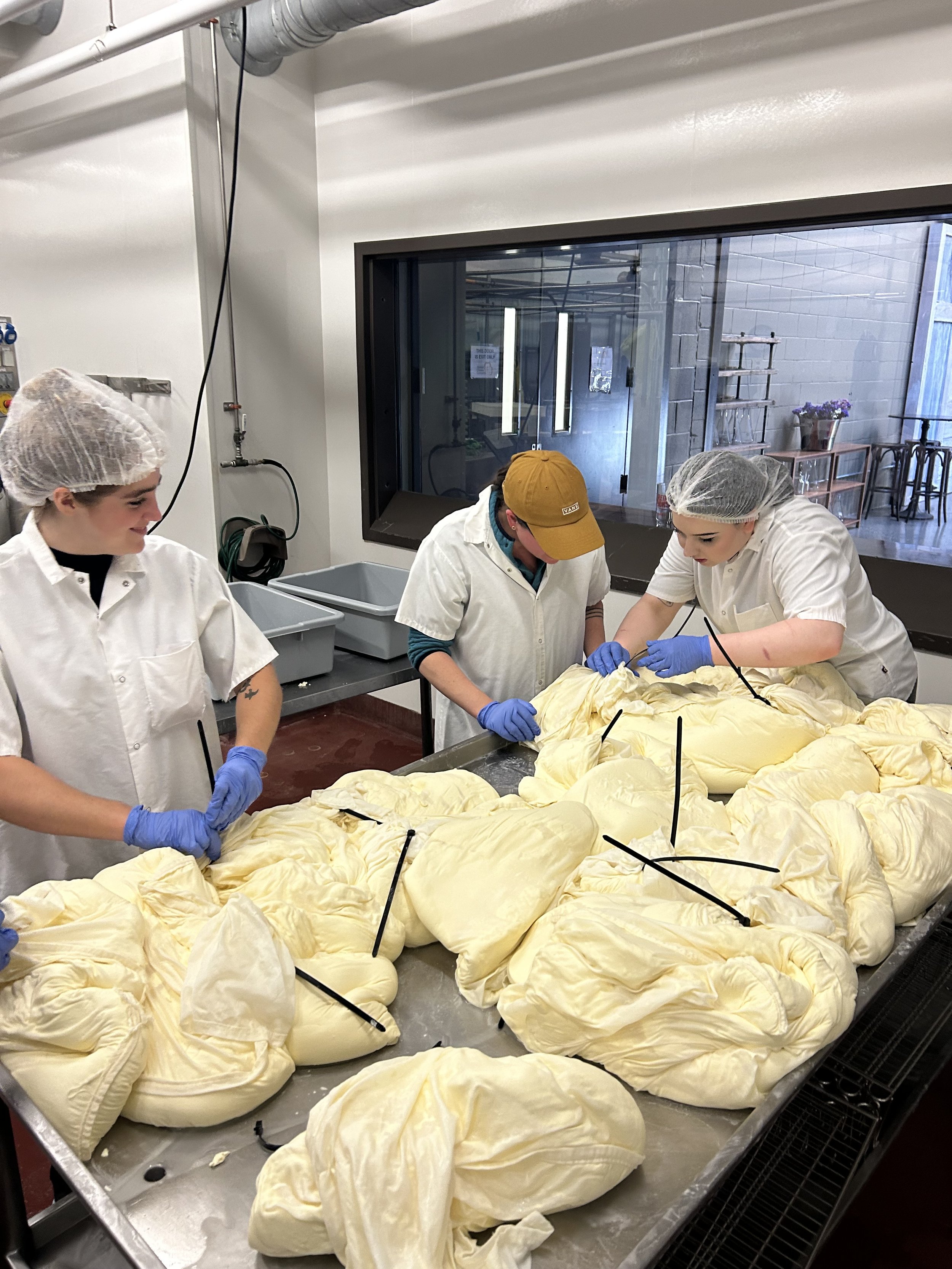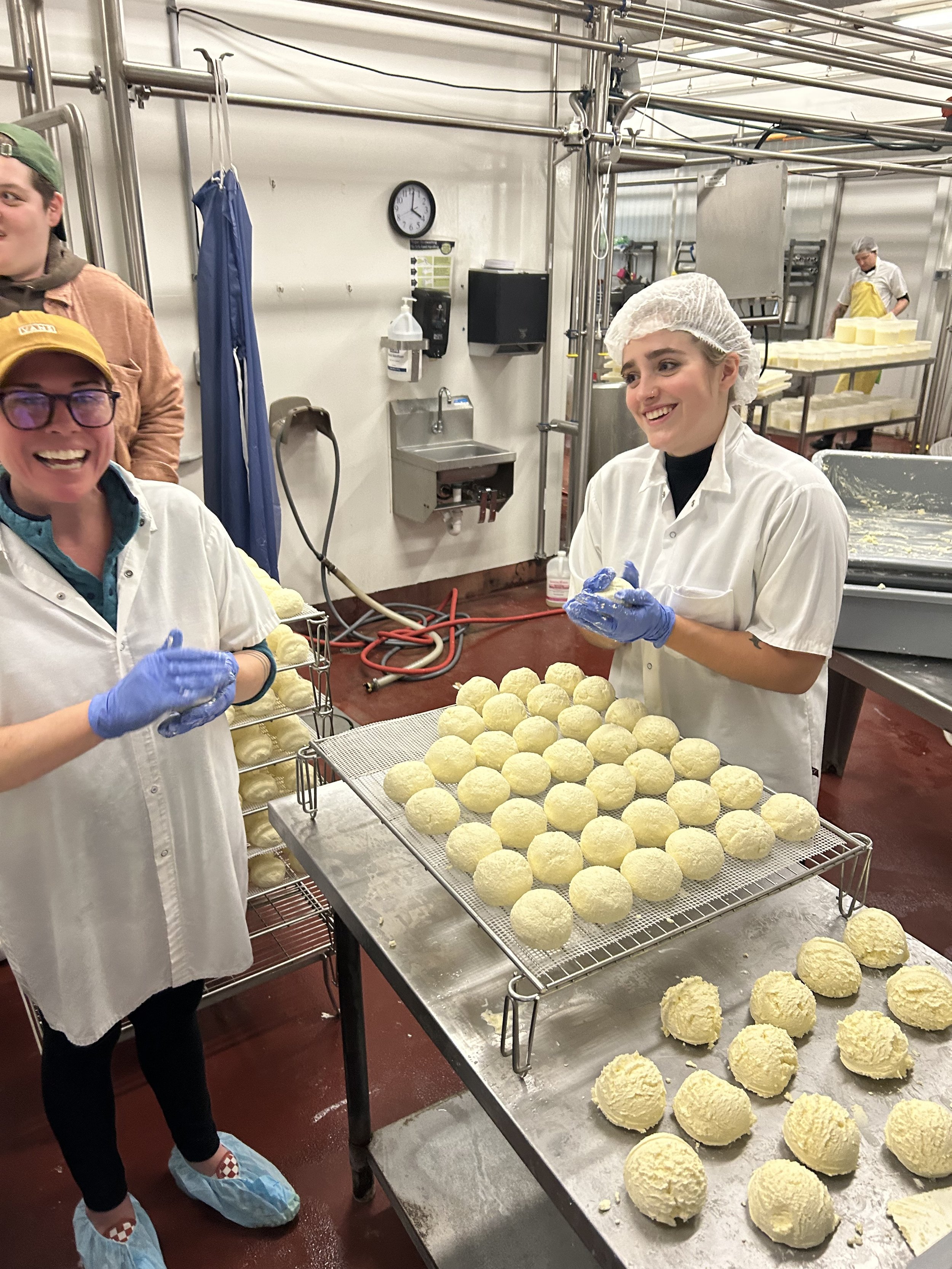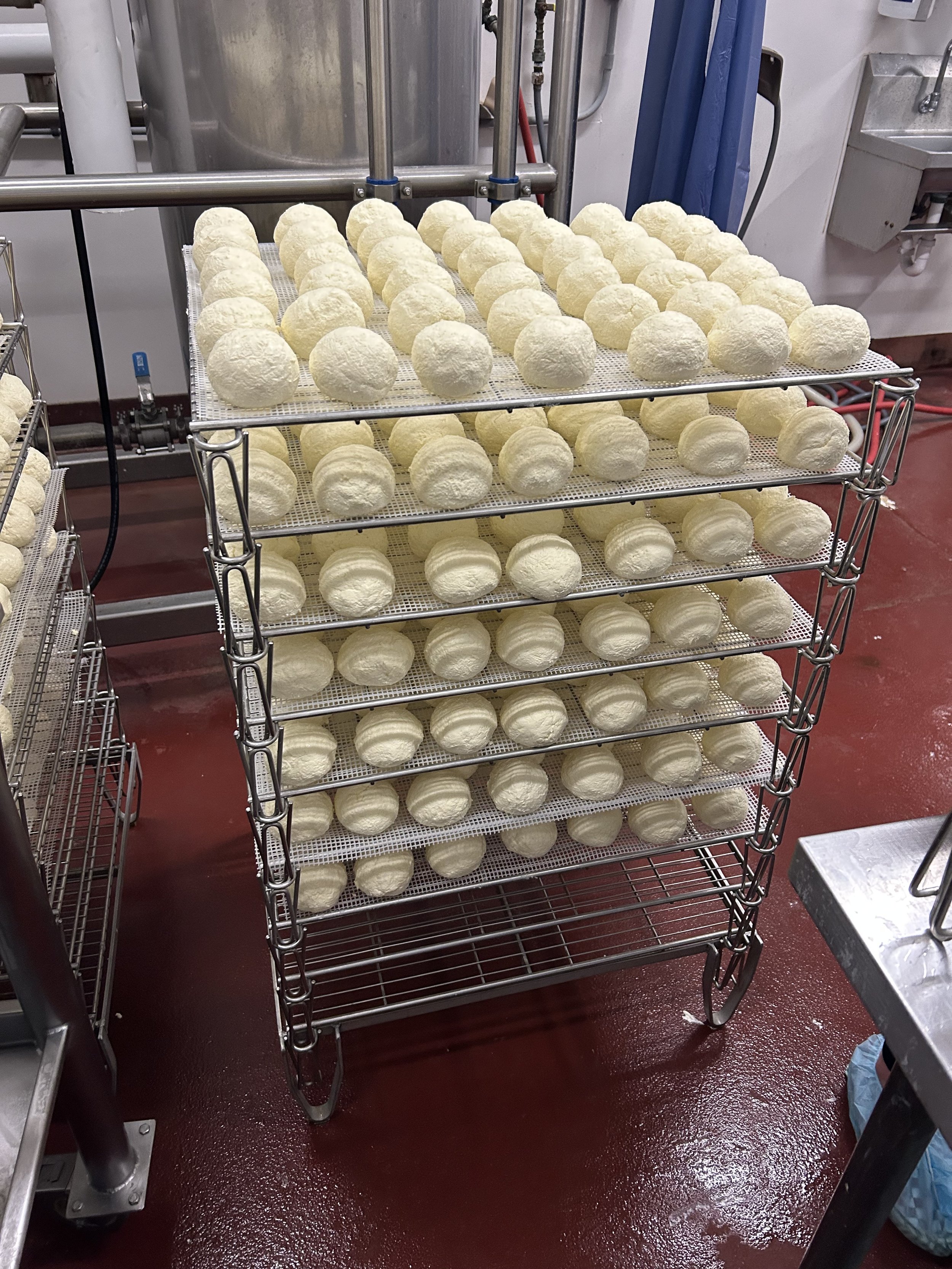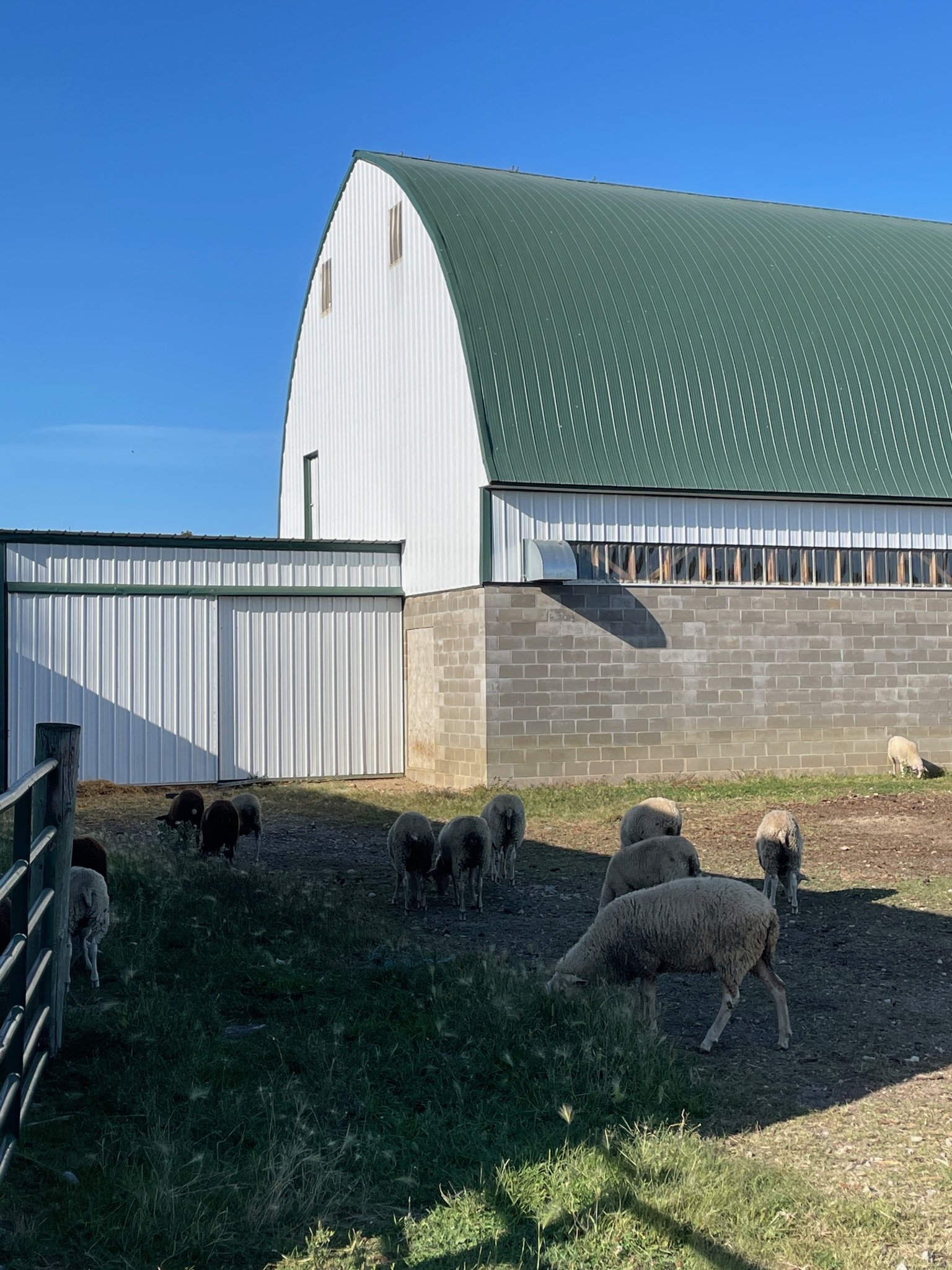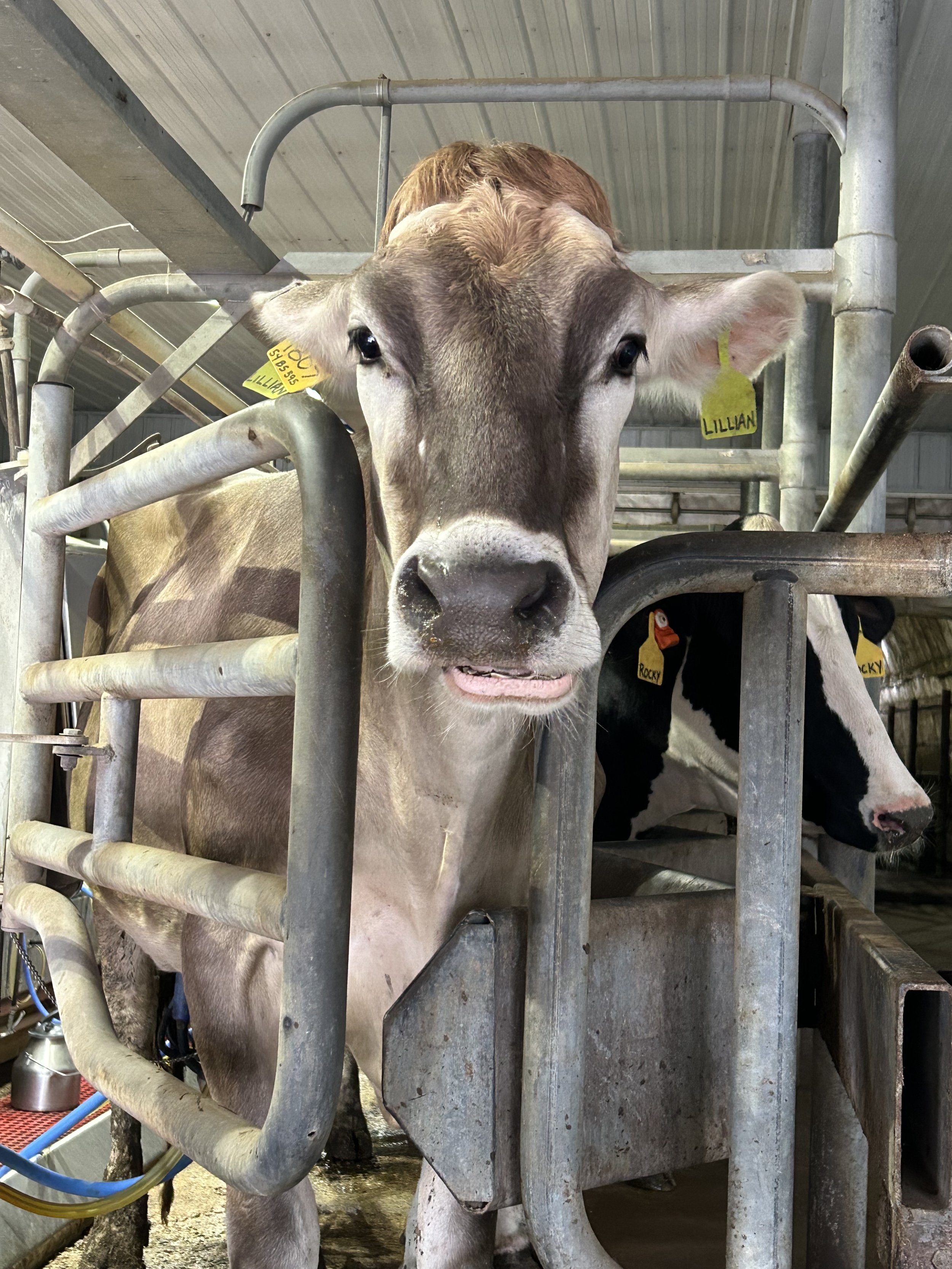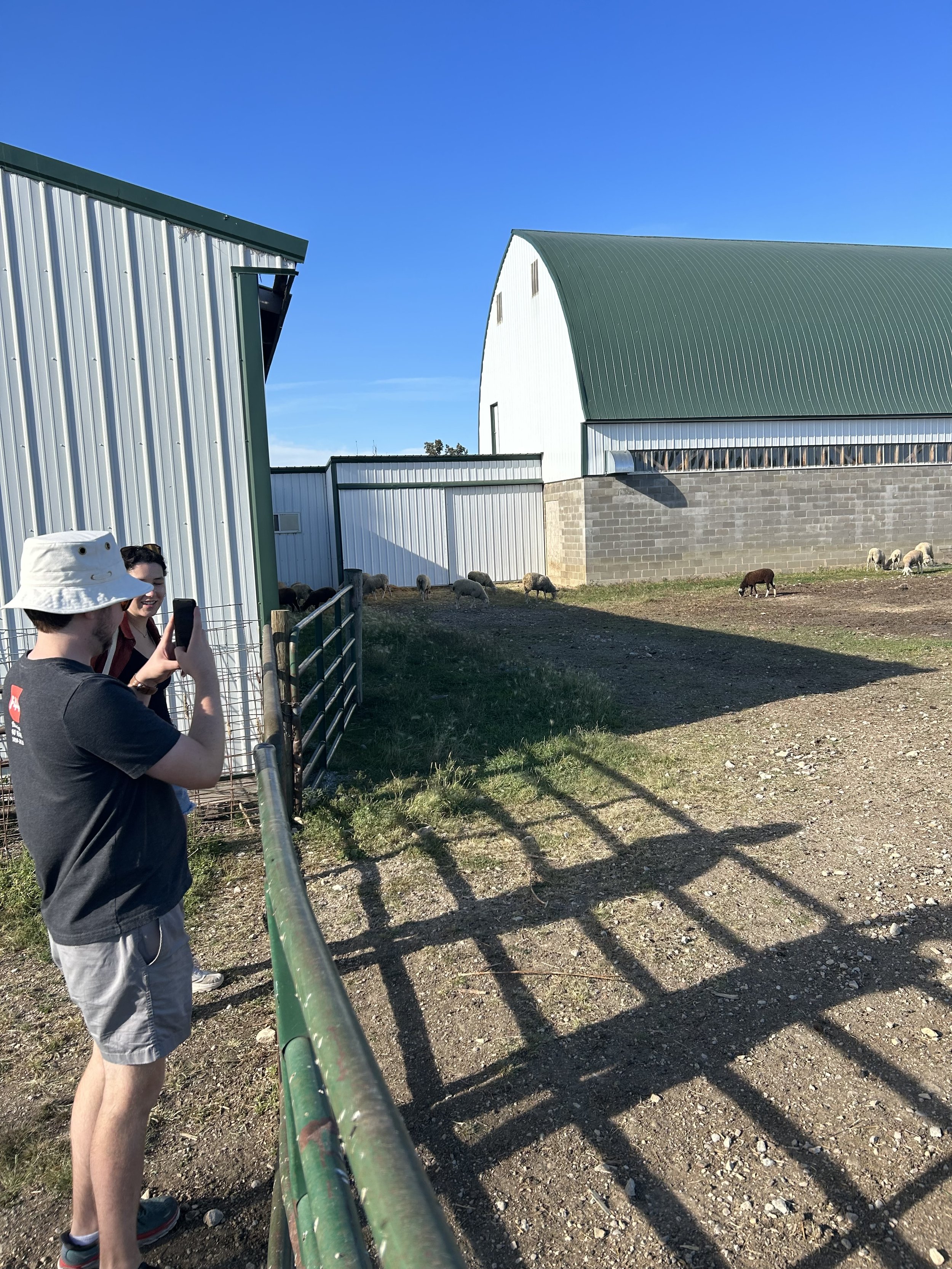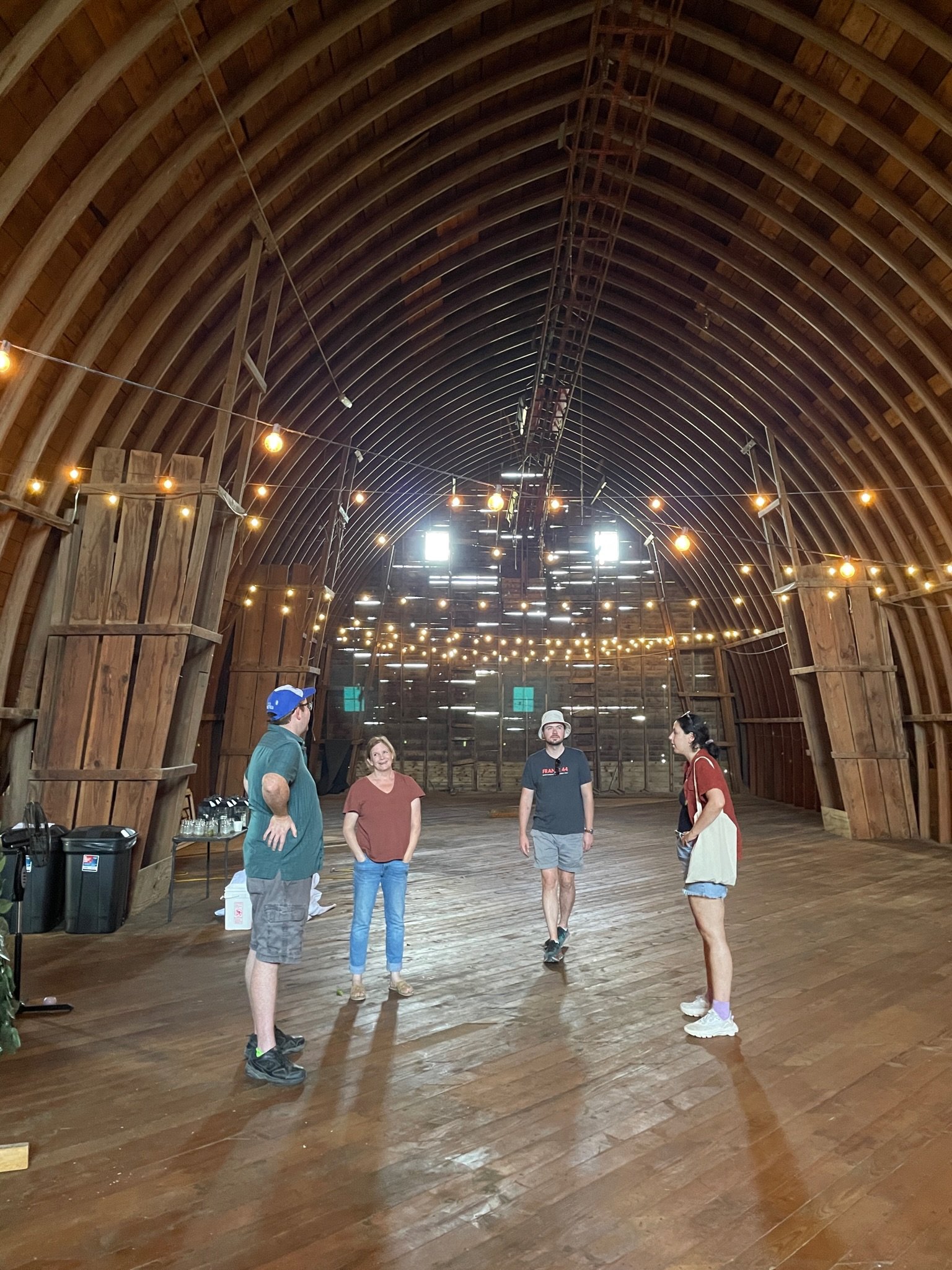One of our longest relationships in artisan cheese has been with Neal’s Yard Dairy in London. For the past 15 years, we’ve bought British farmhouse cheese from their selections. Each week we correspond about what is tasting good and what they think our Minnesota customers (you!) will enjoy. So, of course, I jumped at the opportunity to travel with them on their April “northern run,” a regular trip taken by the team at Neal’s Yard to visit cheesemakers and select the specific batches they’d like to buy. Details were sparse, I only knew that the trip would be packed with visits and that cheese might be our primary source of sustenance.
An Unreal Cheese Made from Real Ingredients
Soft Cheese Pairing Guide
Stilton: The Official Cheese of Christmas
Gotthelf Slow Food Emmentaler
By Austin Coe Butler
Weighing in at a truly colossal 225 pounds, the Gotthelf Slow Food Emmentaler is by far the biggest cheese to have graced our shop. That’s almost three times as heavy as a wheel of Parmigiano Reggiano or Gruyère. It rightfully deserves its stately place in our cheese vault that you can see upon entering the shop. But what’s even more impressive than its stature is its fidelity to traditional practices that make it a delicious piece of living history.
One of the immediate distinguishing features of the cheese is the gorgeous silhouette on top that recounts the tale Die Käserei der Vehfreude, or “The Cheese Factory in Vehfreude,” by Jeremias Gotthelf, a Swiss pastor and writer, whose name the cheese bears in his honor. In the story, the fictional village of Vehfreude is badly in need of a school, but instead constructs a cheese factory to compete economically with its neighboring villages. Vehfreude is set in the Emmen valley (Emmentaler literally means to “someone or something from the Emmen valley) and the cheese the villagers make is, naturally, Emmentaler. Among the comic episodes are market riots over the price of milk, a young woman who believes she is practicing witchcraft being scared straight by a villager dressed as Beelzebub, and the story Felix and Änneli, two star crossed lovers of differing classes. It’s a tale of the greed of man and the triumph of love. And also cheese! The wheel also carries details of the heraldic bear of Bern, Edelweisses, and the Swiss cross at the base of a Blockbau, a traditional Emmental farmhouse. Circling the wheel is a line of cows being led by a cowherd symbolizing the transhumance to the Alpine dairy.
Husband and wife Bernard Meier and Marlies Zaugg make Gotthelf Emmentaler just like the villagers of Vehfreude did back in the 17th century. Isolated in the mountains of their small village, Hüpfenboden, they make just two wheels of cheese a day. That 225 pounds of cheese is condensed from more than 1,100 liters of milk(!). It’s made using kettle whey cultures, wherein the whey from the previous day’s batch of cheese is added to the present day’s milk, carrying over the cultures (like a sourdough starter). Once the cheese is made, it’s taken to Gourmino’s cellars to age under the watchful eyes of the affineurs, tending to the wheels by washing and flipping them. In recognition of the traditional practices this cheese follows, the Slow Food Presidia bestowed an award on traditional Emmentaler.
The struggle to open a 225 pound wheel of cheese is one of the greatest a cheesemonger can face. Certain exigencies immediately presented themselves and could not be ignored. First of all, the cheese was too large to store in any of our refrigerators, which meant that after a day of tempering, we needed to break it into more manageable pieces. The weight meant that this cheese had to be handled by three people, which was further complicated when we realized we could not get it through the door to the cheese shop! Instead we had to right the wheel up on its rounded edge, precariously balancing it on a flatbed to pull it into the shop, and during our first attempt to do this it stubbornly rolled to the floor with a colossal thud. Cutting a cheese this big is also tricky. Driving a chisel knife through the cheese require my full weight, and, normally, after this initial cut a wire could be dragged through it to easily split it. However, we were out of our larger, longer wires, so it had to be cut with the chisel knife all the way through, a more “historic” way to cut a historic cheese. But as soon as the cheese was cracked an incredible smell rose up and the “eyes” or holes in the cheese begins to “cry.”
What does a two hundred pound wheel of cheese taste like? Rich brown butter, toasted cashew, wheat bread, a fresh potato loaf. Even for those that dislike Emmentaler, Gotthelf lacks that distinct “Swiss-y” flavor that is imparted by the Proprionibacteria, the bacteria responsible for producing the signature “eyes” or holes in Emmentaler. Many of us have been exposed to bad “Swiss” cheese as a result of the nefarious business practices of the Swiss cheese Cartels, and the imagine of a deli slice of pallid, plasticine “Swiss” cheese comes to mind. It’s pleasantly surprising then that Gotthelf Emmental is dense, with a cashew-like creaminess and studded with tyrosine crystals while still having the pliability that makes it a phenomenal melter. It is one of the finest expressions of Emmentaler, and an urgent reminder of what makes real Emmentaler such a special cheese whose traditions are worth preserving in the era of globalization.
This promotion couldn’t come at a better time—last week, Gotthelf Emmentaler won a Super Gold at the World Champion Cheese Competition in Trondheim! Stop into the shop to try the best “Swiss” cheese in the world!
Making Apricity with Alemar Cheese
By Joe Kastner
Last week, a team of our Cheese Shop staff had the awesome opportunity to do some cheesemaking with our friends up at Alemar Cheese Company in Northeast Minneapolis. Located in the Food Building, along with Lowry Hill Provisions and Baker’s Field Flour & Bread, Alemar is definitely the creamery closest to France 44, which makes for a great working relationship. We get their cheese delivered along with bread and salami from the same building, and when we need cheese in a pinch, Alemar is our first call! Head Cheesemaker Charlotte Serino has been with the company since 2021, and we are very grateful that she invited us to come make cheese with her!
Apricity has become one of our favorite soft cheeses at the shop, and for good reason! Charlotte just started making this cheese last fall, and it has already gained a lot of buzz. Apricity most recently won Best in Class at the 2023 American Cheese Society Awards, giving it national recognition along with our local appreciation. The name Apricity means “the warmth of the sun in winter”, which I think is just a perfectly romantic name for a new cheese to represent Minnesota.
Apricity is a “lactic-set” cheese, which works a little different than your typical curdy, rennet-set cheeses. This technique is seen frequently in goat’s-milk cheeses, which is where Charlotte learned it. Apricity uses very little rennet to coagulate the milk, instead relying on natural acidification and fermentation over a longer period of time to transform the milk into a smooth, creamy curd. This gives the cheese a great brightness and tangy flavor, along with an almost ricotta-like texture. To turn this curd into cheese, we as a team got to salt the curd, mix it up, and then scoop it into snowball-sized spheres and roll into perfect orbs.
The batch that we helped make is now on sale at our shop!
We thank Charlotte and the Alemar team for inviting us in and showing us around. Connecting with local, talented cheesemakers is one of the best parts of working in a small cheese shop, and seeing how cheese is made and where it comes from can only help us be better stewards of their products! If you’re looking for a new softy to fall in love with this fall, come give Apricity a try!
France 44 Farm Visits: Redhead Creamery & Shepherd’s Way Farm
by Joe Kastner
Last week, a group of our mongers from the Minneapolis shop got the chance to go visit a couple local creameries and see first-hand where some of our cheeses come from. We got to go visit Redhead Creamery out west in Brooten, and Shepherd’s Way in Nerstrand, which is just down by Northfield. Seeing these family farms, hearing their stories and why they make cheese, this is what our cheese counter is all about: connecting with our neighbors through food and celebrating the talented makers of cheese near and far.
Redhead Creamery has been making cheese for 10 years now, but this year in particular is bound to be a big one for them. We were greeted by cheesemaker Alise Sjostrom with a bowl of squeaky fresh cheese curds made earlier that morning, who then proceeded to give us a tour of all the new goings-on at the farm. Just within the last month or so, they’ve added some awesome automation for the farming side of things, including an automated milking machine, where the cows milk themselves! This will give Alise and the team even more time for cheesemaking and playing with recipes, as well as their other big project, a new distillery! The Redhead team plans on using the whey from cheesemaking to distill into spirits, and then serve those spirits at their all-new dine-in expansion, which we got to see the development of! We’re all very excited for these next steps at Redhead and can’t wait to see what’s next for them!
The very next day another group got to travel down past Northfield to see Jodi Olsen Read at Shepherd’s Way Farms. Despite some issues with their water well that had just come up the night before, Jodi very graciously hosted us, showed us around the farm, and served us a delicious assortment of sheep’s cheeses, some of which you can find at our cheese counter! We got to tour the milking and make facilities, and even got to see the cavernous upper level of the barn that had just been used for a family wedding reception. Jodi has been making cheese for about 25 years now, and has really honed her craft with the different varieties of cheese Shepherd’s Way puts out. You can also find them at many farmer’s markets around the city, where they also sell their sheep’s milk by the bottle, which is a real treat. We love selling Shepherd’s Way cheeses and hope you’ll try one next time you’re in the shop!
ACS Winners Pt. 4: Uplands Cheese
by Austin Coe Butler
In our weeks-long celebration of American Cheese Society Award Winners, there isn’t a cheese as near and dear to our hearts, and our customers’, as the next big winner: Uplands Cheese Company’s Pleasant Ridge Reserve. As the most awarded cheese in American, Pleasant Ridge Reserve added three more prestigious awards to its name:
Pleasant Ridge Reserve – 3rd Place – Best in Show
Pleasant Ridge Reserve – 1st Place – Washed Rind Cheeses made from cow’s milk
Pleasant Ridge Reserve – 2nd Place – Farmstead Category Aged 60 days or more less than 39% Moisture made from cow’s milk
Pleasant Ridge Reserve is a special cheese for us. It’s been in our case since the shop opened, and over the years our relationship with cheesemaker Andy Hatch and the team at Uplands has become one of our most cherished. Now, with over fifteen years of friendship, we hand-select the batches of Pleasant Ridge we sell during visits to the dairy. Last year, in an exciting development, we invited Andy to the Events space to invite customers to participate in batch selection as well. Put simply, Pleasant Ridge is great cheese made by great people doing great things for their cows, community, and environment. Whenever an inquisitive customer comes to the cheese counter unsure of where to start eating their way thoughtfully through the multifarious world of cheese, I hand them a wedge of Pleasant Ridge Reserve.
Fans of Uplands’ other cheese, Rush Creek Reserve, might wonder where it is on the list of ACS winners, and the answer is, it isn’t! For good reason. Rush Creek Reserve is a highly seasonal cheese, made during the autumn when the cows transition from fresh pasture to cured hay producing a milk that is less in volume but richer in fat. It arrives in October and is sold out by January, so you won’t ever see it judged by ACS in May, which, frankly, I find refreshing. In an increasingly institutionalized world where we use awards and accolades to justify our tastes, or worse, build our tastes from them, the personal pleasure of food remains a radical tool for conviviality. De gustibus non est disputandum. Pleasant Ridge Reserve doesn’t taste any better with each award it wins. It tastes great in spite of them.
As a beautiful melter and a great snaking cheese that can handle the summer heat, Pleasant Ridge Reserve is the perfect cheese to have a big wedge of this Labor Day weekend. And as an added level of intrigue, those of us who tried the day’s batch that was judged at ACS this year thought the two batches we selected alongside our customers were even better! Come visit the shop the weekend to grab and wedge and taste why it continues to remain America’s most awarded cheese!
ACS Winners Pt. 3: Shepherd’s Way
by Austin Coe Butler
Continuing our series on American Cheese Society Award Winners, this week we’re featuring another Minnesota winner—Shepherd’s Way Farm in Nerstrand! Shepherd’s Way won in the following categories:
Burr Oak – 3rd Place – Sheep’s Milk Cheese Aged Over 60 Days
Sogn – 3rd Place – Farmstead Category Sheep’s Milk Cheese Aged Over 60 Days
What more needs to be written about Shepherd’s Way Farm? I maintain that Jodi is the nicest person working in cheese, which is saying a lot, and that Shepherd’s Way is producing some of the best cheese in the state.
Their ACS winning cheeses are no exception. Burr Oak an extra-firm, extra-nutty aged cheese is a special release and isn’t currently available, but Sogn Tomme (pronounced SOHN) has become a year-round counter staple for us. It’s bright, mineral tang makes it the perfect companion whether you’re enjoying the summer sun or burrowed away in the bleak, midwinter. Sogn is one of Shepherd’s Way’s newest cheeses, and last year at ACS it actually won 1st place in its category!
We have a lovely selection of Shepherd’s Way cheeses in our case at the moment from their creamy brie-like Hidden Falls and tangy Big Woods Blue to Sogn Tomme and a few flavors of Shepherd’s Hope, their divine, fresh sheep’s milk cheese that is somewhere between feta and mozzarella in taste and consistency. To me, Shepherd’s Way Farm’s cheeses all scream refreshing, something we’ll need this broiling weekend. Swing by the shop this week to try some more award winning cheese made right here in Minnesota (and enjoy the AC)!
ACS Winners Pt. II: Alemar Cheese Company
by Austin Coe Butler
This week, in our month-long celebration of American Cheese Society Award Winners, it’s time for the hometown hero: Alemar Cheese Company! Alemar won in the following categories:
Apricity – 1st Place – Soft-Ripened Cheeses made from Cow’s Milk
Blue Earth – 2nd Place – Soft-Ripened Cheeses made from Cow’s Milk
This means that in the category of soft-ripened cheeses made from cow’s milk Alemar took both top spots! Let me rephrase that: Out of all the soft-ripened cow’s milk cheeses that were submitted from across the nation, not one but two cheeses from right here in Minneapolis rose to the top in America’s fiercest food-fight!
What’s also remarkable about Apricity’s win is that Apricity was only created last September—this is a debut win. Within just a few months it’s become the darling of the American artisan cheese scene, and it’s easy to see why. With its gorgeous orange glow, mouse-like texture, a bright, lactic tang, Apricity is a crave-able cheese for all occasions.
Alemar Cheese Company was founded in 2008 by Keith Adams in Mankato. Keith wanted to make artisanal, French-inspired soft-ripened cheeses like Brie and Camembert using milk from small Minnesota family farms. Their first cheese was Bent River, a Camembert-style cheese that quickly picked up two ACS honors and a Good Food Award. In 2019, Keith and his team moved to the FOOD BUILDING in NE Minneapolis where Charlotte Serino joined as Head Cheesemaker.
We currently have Apricity, Boom Island, their smaller camembert-style cheese, and Sakatah, a soft cheese wrapped in grape leaves and soaked in Brandy, in our case. Stop by the cheese counter this weekend to try a sample of Alemar’s cheeses and taste what makes them award-winning!





